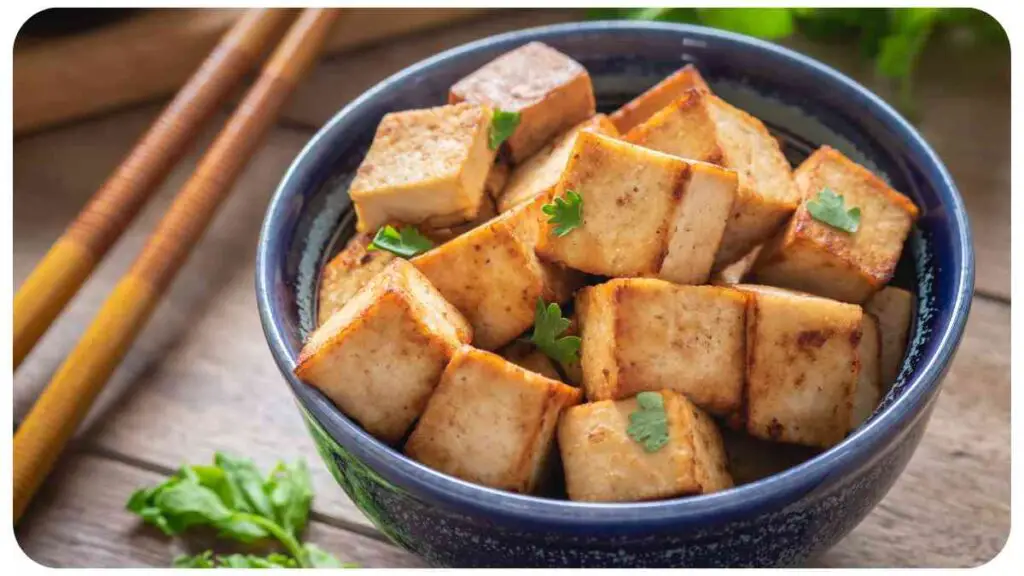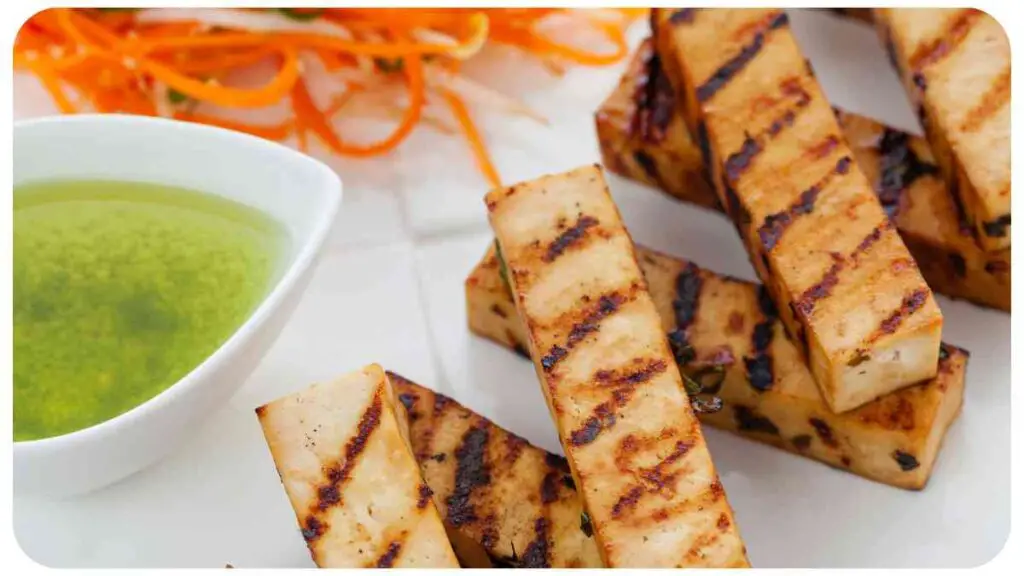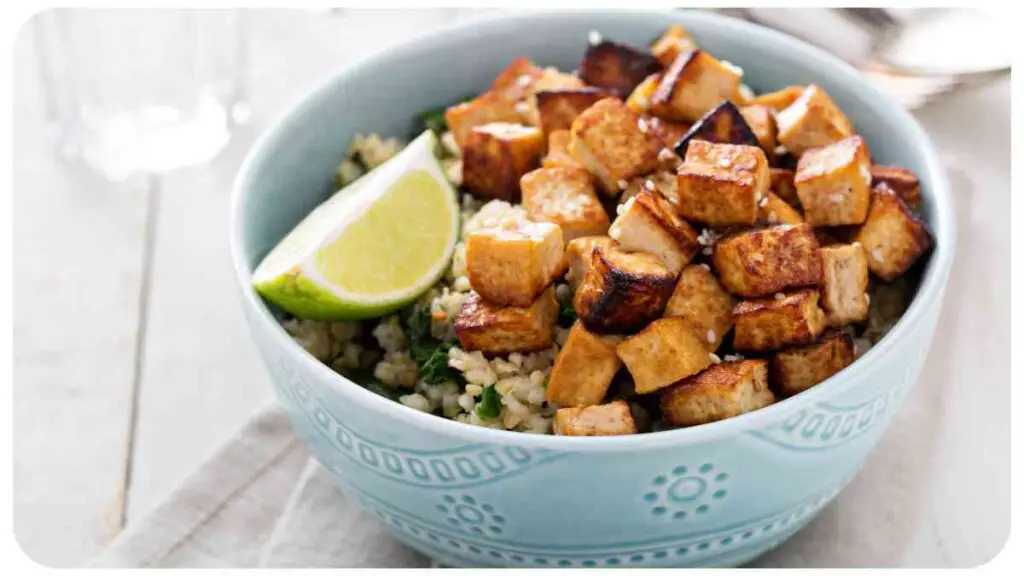Welcome to this comprehensive guide on cooking tofu the right way! Whether you’re a tofu enthusiast or a beginner exploring plant-based options, this guide will equip you with the knowledge and techniques to prepare delicious tofu dishes that leave you wanting more.
In this guide, we will cover everything from understanding the different types of tofu to various cooking techniques, flavoring options, and even troubleshooting common tofu issues.
Let’s dive in and unlock the secrets to cooking tofu to perfection!
| Takeaway |
|---|
| Tofu is a versatile ingredient that can be cooked in various ways, such as grilling, stir-frying, or adding it to soups and salads. |
| Properly pressing tofu before cooking helps remove excess moisture and improves its texture. |
| Marinating tofu allows it to absorb flavors and enhances its taste. |
| Pair tofu with different ingredients like vegetables, grains, and sauces to create well-balanced and delicious meals. |
| Tofu is a great source of plant-based protein, low in saturated fat and cholesterol, and rich in minerals and antioxidants. |
| Storing tofu properly, either unopened or opened, helps maintain its freshness. |
| Freezing tofu is an option to extend its shelf life, but it may change the texture. |
| Troubleshooting common tofu issues, such as tofu falling apart or turning chewy, can be overcome by proper pressing and cooking techniques. |
| Exploring further reading and recipes can provide additional guidance and inspiration for cooking with tofu. |
| Frequently asked questions cover topics such as eating tofu raw, pressing tofu, marinating time, freezing tofu, and the difference between firm tofu and silken tofu. |
2. Why Cook Tofu?
Before we jump into the intricacies of cooking tofu, let’s take a moment to understand why you should incorporate it into your culinary repertoire. Tofu, made from soybeans, is a versatile and nutritious plant-based protein that can be used in a variety of dishes.
It is particularly popular among vegetarians, vegans, and health-conscious individuals due to its high protein content and low fat levels.
The mild flavor and ability to absorb flavors make tofu an excellent canvas for your culinary creativity. Whether you’re looking to explore new flavors or find alternatives to meat-based dishes, cooking tofu opens up a world of possibilities.
When dining out, mastering vegan choices can be a breeze. Learn how to navigate menus and ensure delicious vegan meals at any restaurant with this quick and easy guide
3. Understanding Tofu

Different Types of Tofu
Tofu comes in various forms, each with its own unique characteristics. The most commonly found types of tofu are firm tofu, soft tofu, and silken tofu.
| Tofu Type | Texture | Best Suited For |
| Firm Tofu | Dense and sturdy texture | Stir-frying, grilling, baking |
| Soft Tofu | Creamy and delicate texture | Soups, stews, dressings, desserts |
| Silken Tofu | Smooth and custard-like texture | Blending into sauces, spreads, smoothies |
Understanding the differences among these types of tofu will help you select the right one for your cooking needs.
Nutritional Benefits of Tofu
Besides being a fantastic source of plant-based protein, tofu has various health benefits. It is low in calories and cholesterol-free, making it a heart-healthy alternative to animal proteins. Tofu is also rich in essential amino acids, vitamins, and minerals, including iron, calcium, and manganese.
Incorporating tofu into your diet can promote good bone health, aid in weight management, and lower the risk of certain chronic diseases. Its versatility and high nutrient content make tofu an excellent addition to any balanced diet.
Discover a variety of vegan protein sources and learn how to incorporate them into your meals. This comprehensive guide covers everything you need to know to meet your protein needs on a plant-based diet.
4. Preparing Tofu for Cooking
To ensure that your tofu dishes turn out flavorful and satisfying, proper preparation is key. Here are a few techniques to enhance the texture and flavor of your tofu before cooking.
Pressing Tofu
Pressing tofu helps remove excess water, allowing it to absorb flavors better and achieve a firmer texture. Start by cutting the tofu into desired shapes, such as cubes or slices. Place the tofu between two plates lined with paper towels or a clean kitchen towel, and place something heavy on top, like a cast-iron skillet or cans.
Let it sit for about 15-30 minutes, changing the towels if necessary. The pressing process firms up the tofu, making it less likely to fall apart during cooking.
Marinating Tofu
Marinating tofu gives it an opportunity to soak up delicious flavors and spices. Prepare a mixture of your favorite marinade ingredients, such as soy sauce, garlic, ginger, and herbs. Ensure the marinade is well-seasoned and flavorful, as tofu acts as a blank canvas that can be transformed by the marinade.
Place the pressed tofu in a shallow dish or resealable bag and cover it with the marinade. Allow it to marinate in the refrigerator for at least 30 minutes, or up to several hours for a more intense flavor.
Freezing Tofu
Freezing tofu is a fantastic technique that changes its texture, making it more spongy and chewy. This is especially useful for those who prefer a meat-like texture in their tofu dishes. After pressing the tofu, wrap it in plastic wrap or place it in a freezer-safe container and freeze for at least 24 hours.
Thaw the tofu in the refrigerator before using it in your desired recipe. The frozen and thawed tofu will have a more porous structure, allowing it to absorb marinades and sauces more effectively.
New to veganism? Transition effortlessly with the help of valuable tips and tricks in this vegan diet for beginners guide. Make your journey into veganism a smooth and enjoyable one.
5. Cooking Techniques for Tofu
Now that you have prepared your tofu, it’s time to explore the various cooking techniques that will bring out its best flavors and textures. Here are some popular methods for cooking tofu:
Pan-Frying Tofu
Pan-frying tofu creates a crispy exterior while maintaining a tender and flavorful interior. It’s a versatile cooking method suitable for a wide range of dishes.
Basic Pan-Fried Tofu Recipe
- Heat a non-stick skillet over medium-high heat and add a small amount of oil.
- Place the marinated or pressed tofu into the skillet and cook for about 5-6 minutes on each side, until golden brown and crispy.
- Serve the pan-fried tofu on its own as a protein-rich snack or add it to stir-fries, salads, or sandwiches for an extra layer of flavor and texture.
Crispy Pan-Fried Tofu
For an even crispier texture, after pressing the tofu, coat it with a thin layer of cornstarch or flour. This simple step adds an extra crunch to your pan-fried tofu.
Baking Tofu
Baking tofu in the oven is a hassle-free method that yields a firm texture and allows for even cooking.
Baked Tofu with Herbs and Spices
- Preheat your oven to 400°F (200°C) and line a baking sheet with parchment paper.
- Marinate the tofu in your preferred mixture of herbs, spices, and sauces.
- Arrange the tofu on the baking sheet and bake for 25-30 minutes, flipping halfway through, until the tofu is browned and slightly crispy.
- Enjoy the baked tofu alongside roasted vegetables, or use it as a protein topping for salads and grain bowls.
Face common challenges in vegan cooking? Get expert advice with this insightful guide on troubleshooting vegan recipes. Explore common mistakes and their fixes to elevate your culinary adventures
Tofu Nuggets
To create a healthier and plant-based version of crispy nuggets, season tofu cubes with your favorite spices and bake them until golden and crispy. Pair them with a dipping sauce for a delicious snack or a kid-friendly meal.
Grilling Tofu

Grilling tofu adds a delicious smoky flavor and beautiful grill marks to enhance its presentation. Here are a couple of grilling techniques for cooking tofu:
Grilled Tofu Skewers
- Cut firm tofu into cubes and marinate them with a mixture of soy sauce, minced garlic, ginger, and a touch of sesame oil.
- Preheat your grill to medium-high heat and lightly oil the grates.
- Thread the tofu cubes onto skewers and grill for about 10-12 minutes, turning occasionally, until the tofu is crispy and charred around the edges.
- Serve the grilled tofu skewers with your favorite dipping sauce or as a protein component in vegetable skewers.
Teriyaki Grilled Tofu
For a delicious and flavorful dish, marinate the pressed tofu in a tangy and sweet teriyaki sauce. Grill the tofu until it’s nicely caramelized, creating a perfect combination of textures and flavors.
Stir-Frying Tofu
Stir-frying tofu allows it to take on the flavors of the other ingredients in the dish while maintaining a soft and silky texture.
Tofu and Vegetable Stir-Fry
- Heat a wok or large skillet over high heat and add some oil.
- Toss in sliced vegetables like bell peppers, mushrooms, and broccoli florets. Stir-fry for a few minutes until the vegetables are slightly tender.
- Push the vegetables to the side and add cubed tofu to the center. Cook until the tofu is lightly browned and heated through.
- Combine the vegetables and tofu, stir in your favorite stir-fry sauce or seasonings, and continue to cook for another minute or two.
- Serve the tofu and vegetable stir-fry over rice or noodles for a satisfying and wholesome meal.
Spicy Mapo Tofu
Mapo Tofu is a popular Sichuan dish with the perfect balance of spiciness and savory flavors.
6. Flavoring and Seasoning Tofu
To elevate the taste of tofu, it’s essential to incorporate flavorings and seasonings that complement its neutral nature. Here are some ways to add delicious flavors to your tofu dishes:
Asian-Inspired Sauces and Marinades
Asian-inspired sauces and marinades can transform tofu into a mouthwatering dish. Experiment with classic soy sauce-based marinades, teriyaki sauce, hoisin sauce, or gochujang for a spicy kick. These sauces infuse tofu with savory, umami-rich flavors that are irresistible.
Unlock the world of plant-based cheese-making with this step-by-step guide to making vegan cheese. Create dairy-free artisanal delights and elevate your vegan culinary repertoire with this comprehensive resource.
Spices and Herbs for Tofu
Spices and herbs are excellent additions to enhance the taste of tofu. Use aromatic spices like garlic, ginger, and turmeric to create depth and complexity. Fresh herbs like cilantro, basil, and mint can bring a burst of freshness to your tofu dishes. Don’t be afraid to experiment with different spice blends and herbs to find unique flavor combinations that you love.
Cooking Tofu with Broths and Stocks
Cooking tofu in broths and stocks adds layers of flavor and creates a more robust and satisfying dish. Incorporate vegetable broth, miso soup as a base, or even coconut milk for a creamy and flavorful finish. The tofu will soak up the essence of the broth, making each bite a delight.
7. Pairing Tofu with Other Ingredients
Tofu is a versatile ingredient that can be paired with a variety of other ingredients to create delicious and balanced meals. Here are some ideas for pairing tofu with different food groups:
Tofu and Vegetables
Combine tofu with an array of colorful and nutritious vegetables to create vibrant and wholesome dishes. Stir-fries, curries, Buddha bowls, and vegetable-packed salads are just a few ideas to get you started.
Experiment with different cooking techniques and flavor combinations to find your perfect tofu and vegetable pairings.
Tofu and Grains
Tofu pairs well with various grains, providing a complete protein source and a satisfying meal. Add pan-fried tofu to a quinoa salad, stuff it into a wrap with brown rice, or serve it over a bed of steamed jasmine rice. The combination of tofu and grains is not only delicious but also packed with essential nutrients.
Tofu in Soups and Salads
Incorporate tofu into soups and salads for a protein boost. Add cubed tofu to vegetable noodle soups, spicy ramen bowls, or miso soup for added texture and substance.
Tofu can also add a protein-packed element to refreshing salads when marinated and grilled or paired with fresh ingredients like cucumbers, tomatoes, and leafy greens.
Tofu in Sandwiches and Wraps
Transform your sandwiches and wraps into satisfying and nutritious meals by adding tofu. Thinly sliced pan-fried tofu or marinated grilled tofu can be a delicious filling alongside fresh veggies, spreads, and crunchy toppings.
Whether it’s a classic BLT, a teriyaki tofu wrap, or a Mediterranean-inspired pita pocket, tofu can be a fantastic addition to your handheld meals.
8. Troubleshooting Common Tofu Issues
While cooking tofu is generally straightforward, you may encounter a few common issues. Here are some tips to troubleshoot and overcome them:
Tofu Falling Apart While Cooking
If your tofu is falling apart during cooking, it may not have been pressed adequately to remove excess water. Ensure that you press the tofu for at least 15-30 minutes and use a non-stick skillet or a well-seasoned pan for cooking.
Additionally, avoid flipping the tofu too frequently during cooking, as this can cause it to break apart. Gentle handling and proper pressing should help your tofu retain its shape.
Tofu Tastes Bland
If your tofu tastes bland, it may not have absorbed enough flavor. Ensure that you marinate the tofu for a sufficient amount of time to allow it to absorb the flavors.
Additionally, consider using a well-seasoned marinade and seasoning the tofu with spices and herbs before cooking. Lastly, make sure to properly season your dish as a whole to enhance the overall flavor.
Tofu Turning Chewy or Rubber-like
Overcooking tofu can lead to a chewy or rubber-like texture. To avoid this, ensure that you cook tofu just until it is firm and lightly browned. Avoid overcooking or using high heat for an extended period. Adjust cooking times and temperatures based on your preferred tofu texture, and remember to keep the cooking process quick and controlled.
9. Storing Tofu
Properly storing tofu is important to maintain its freshness and quality. Here are some guidelines for storing tofu:
Unopened Tofu
Unopened tofu can be kept in the refrigerator and should be stored according to the package instructions. Typically, unopened tofu can stay fresh for about 3-5 days, but it’s best to check the expiration date on the package.
Opened Tofu
Once you have opened a package of tofu, it should be stored in water. Transfer the tofu to an airtight container and cover it with fresh water. Change the water daily to keep the tofu fresh. Properly stored, opened tofu can last in the refrigerator for about 3-4 days.
Freezing Tofu
If you have excess tofu or want to extend its shelf life, freezing is an option. Here’s how to freeze tofu properly:
- Drain the tofu from its packaging and pat it dry.
- Wrap the tofu tightly in plastic wrap or place it in a freezer-safe container, ensuring there are no air pockets.
- Label the package with the date of freezing to keep track of its freshness.
- Tofu can be frozen for several months. Before using, thaw it in the refrigerator overnight.
While freezing tofu can change its texture, it is a great option if you plan to use it in stir-fries, soups, or recipes where a more crumbled or chewy texture is desirable.
Remember, always check the tofu for any signs of spoilage before using. If it smells off, has an unusual texture, or shows signs of mold, it’s best to discard it to ensure your safety.
10. Health Benefits of Tofu

Tofu is not only a versatile and delicious ingredient but also offers several health benefits. Here are some notable benefits of including tofu in your diet:
Excellent Source of Plant-Based Protein
Tofu is known for being a great source of plant-based protein, making it a valuable option for vegetarians, vegans, or anyone looking to reduce their meat intake. It contains all essential amino acids, making it a complete protein. Adding tofu to your meals helps meet your protein needs and supports muscle growth and maintenance.
Low in Saturated Fat and Cholesterol
Compared to animal-based sources of protein, tofu is relatively low in saturated fat and cholesterol. A diet low in saturated fat and cholesterol can help maintain heart health and reduce the risk of cardiovascular diseases. Tofu provides a healthy alternative to high-fat animal proteins while still delivering essential nutrients.
Rich in Minerals
Tofu is a rich source of minerals such as calcium, iron, magnesium, and phosphorus. Calcium is vital for maintaining strong and healthy bones, while iron is important for oxygen transport in the blood.
Consuming tofu regularly can contribute to meeting your daily mineral requirements, especially for those following a plant-based diet.
Contains Antioxidants and Phytochemicals
Tofu contains antioxidants and phytochemicals, which are beneficial compounds that protect the body against oxidative stress and inflammation. These compounds have been associated with various health benefits, including reducing the risk of chronic diseases such as certain cancers, heart disease, and age-related conditions.
Promotes Hormonal Balance
Tofu is a natural source of isoflavones, a type of phytoestrogen. Isoflavones have been shown to have estrogen-like effects and may benefit hormonal balance, especially in menopausal women. Research suggests that isoflavones may help alleviate symptoms such as hot flashes and promote bone health.
Remember to incorporate tofu into a well-balanced and varied diet to maximize its health benefits. If you have specific health concerns or dietary restrictions, it’s always best to consult with a healthcare professional or registered dietitian for personalized advice.
Conclusion
In conclusion, tofu is a versatile and nutritious ingredient that can be prepared and cooked in various ways to suit your tastes and preferences. It provides a range of health benefits, including being a great source of plant-based protein, low in saturated fat and cholesterol, rich in minerals, and containing valuable antioxidants and phytochemicals.
By properly preparing, cooking, and pairing tofu with other ingredients, you can create delicious and satisfying meals that are not only flavorful but also contribute to a well-rounded and nutritious diet.
So go ahead, experiment with tofu in your kitchen and enjoy the many possibilities it offers for tasty and healthy meals!
Further Reading
Here are some additional resources to explore for more information and tofu recipe inspiration:
Love and Lemons: How to Cook Tofu – This article provides helpful tips and techniques for cooking tofu, including pan-frying, baking, and grilling methods. It also offers creative recipes to try.
Minimalist Baker: Quick & Easy Crispy Tofu – Discover a simple yet delicious recipe for crispy tofu with minimal ingredients and steps. This recipe yields perfectly crispy tofu that can be enjoyed as a standalone dish or added to various meals.
Food Network: How to Cook Tofu – This comprehensive guide from Food Network covers various tofu cooking techniques, including tips on pressing, marinating, and stir-frying. It also provides additional tofu recipe ideas.
FAQs
Can I eat tofu raw?
While tofu can be eaten raw, it is more commonly cooked before consumption. Cooking tofu helps improve its texture, enhance flavors, and reduce any potential risks associated with consuming raw soy products.
How do I press tofu?
To press tofu, start by draining the water from the package. Place the tofu block on a plate lined with paper towels. Add more paper towels on top, followed by a heavy object like a plate or a cutting board. Allow the tofu to press for at least 15-30 minutes to remove excess moisture.
How long does tofu need to marinate?
The marinating time for tofu can vary depending on the recipe and desired flavor intensity. As a general guideline, marinating tofu for at least 30 minutes to a few hours can enhance its taste. However, some recipes may require longer marinating times, so follow the instructions provided in the specific recipe you’re using.
Can I freeze tofu?
Yes, tofu can be frozen. Before freezing, drain the tofu and pat it dry. Wrap it tightly in plastic wrap or place it in a freezer-safe container. Thaw the tofu in the refrigerator before using, and note that freezing changes the texture of tofu, making it more crumbly or chewy.
What’s the difference between firm tofu and silken tofu?
Firm tofu has a denser texture and holds its shape well during cooking, making it suitable for stir-frying, baking, or grilling. Silken tofu has a more delicate texture, almost custard-like, and is ideal for blending into smoothies, sauces, or desserts. The choice between firm and silken tofu depends on the desired texture and recipe requirements.

Hi! My name is Hellen James, and I’m a vegan lifestyle enthusiast. I’ve been living the vegan lifestyle for over 10 years now, and it’s been one of the best decisions I’ve ever made. The food is amazing, the community is incredible, and there’s no way I could go back after experiencing all this firsthand.


